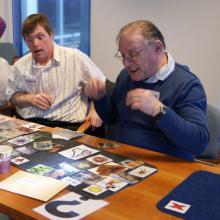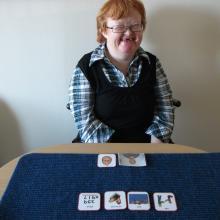Please provide a brief description of what you did in terms of creating, using or sharing evidence to inform or improve your work/organisation
This case study describes the use of Talking Mats at Stenhouse Child and Family Centre (Edinburgh City Council) with very young, vulnerable children and their parents.
Talking Mats is a low-tech communication tool originally developed by the Alternative and Augmentative Communication Research Unit to support people with communication impairment including those with stroke, learning disability and dementia.
Stenhouse Child and Family Centre often work with very vulnerable children who have experienced significant adversity and trauma in their lives. This often means that children are hyper vigilant and find new people and experiences stressful and at times impossible. Child Protection systems can heighten these children's stress levels and as research into early brain development attests, stress can have a significant impact on children. Though it is often inappropriate for very young children to be part of meetings and children's hearings, the Stenhouse team identified a huge gap in empowering and ensuring that these children's views and wishes were represented.
Leanne Turner, the Depute Manager at the Centre was part of a pilot scheme in her previous post using Talking Mats with children within school review systems. She was so impressed with the impact of using this communication tool that she wanted to see if it could work with under fives, children within child protection and vulnerable adults with learning difficulties.
This case study relates to evidence-informed practice in several ways. First, Talking Mats is an evidence-informed tool in itself. It was developed through extensive research so this case study demonstrates the use of existing evidence. Second, staff at Stenhouse explored the use of Talking Mats, gathering and documenting its effectiveness thereby creating new evidence. Third, Talking Mats is a tool for gathering evidence of the views, feelings and wishes of children and their parents and sharing it with professionals.
What was the process you went through?
The use of Talking Mats at the Centre was implemented and overseen by the Depute Manager, who had undergone the Talking Mats training.
Talking Mats were used at the Centre in different contexts. It was tried out in different rooms of the nursery to find out which environments put the children at ease. It was used with very young children, with parents with learning difficulties involved in the Children's Hearing system, for family work and for reviews. Evidence about the effectiveness of the tool and experience of children, parents and staff were documented.
What were the barriers or challenges?
There is some preparation time required in order to use Talking Mats. This includes undergoing training to ensure the tool is used properly. Time and consideration also need to be taken to ensure a comfortable and relaxed environment is created in which to work on a Mat with the child.
What supports or resources helped you to succeed/deliver?
Support from the Centre's management to try something new was very helpful as was the Depute Manager's previous experience with Talking Mats. The commitment and willingness of Centre staff to explore a new method of providing a way for vulnerable children and their families to have their views shared and documented was invaluable.
What were the outcomes of your activities? Do you have evidence to support this?
The outcomes of using Talking Mats at the Centre were that children and parents receiving support felt empowered, listened to and included in processes and decisions. A boy with significant difficulties was helped by a worker using a Talking Mat to express who he would like to live with and to understand about what went on in the meetings he was not permitted to attend. Parents with complex learning disabilities were supported to understand a Children's Hearing and what a supervision order involved. A Talking Mat was used to facilitate a conversation between a three year old boy and his mother who had personality disorder to explain to her how he felt when she shouted at him. Talking Mats have even proved useful with children as young as twenty months.
The staff team at the Centre also felt empowered. They reported feeling that they are now acting more as advocates for the vulnerable children and families that they work with but also felt confident in challenging decisions if they had the evidence through a Talking Mat that the intervention may not be in the child or adult's best interests. They have also challenged other professionals in their thinking and ensured that the voices of vulnerable families they are working with do not get lost in a room full of professionals.
Talking Mats - case study evidence
- Talking Mats and Reviews
- Talking Mats and the Children's Hearing system
- Talking Mats and Very Young Children
- Talking Mats and Family Work
- Talking Mats: A Practitioner's Perspective
What have you learnt?
Talking Mats can help to empower very young, vulnerable children and their parents through decision-making processes within Child Protection processes and the Children's Hearing System. It enhances communication and engagement between children, their parents, staff and other professionals ensuring decisions are evidence-informed.
Any other comments
The Centre was delighted to win Edinburgh City Council's award for creativity and innovation for their use of Talking Mats.
"We are excited about how this may grow and develop in the future and would like more opportunities to share what we have learned. Talking Mats is such a simple tool to use and you don't need lots of expense or time consuming training." - Manager, Stenhouse Child and Family Centre
Notes
- Iriss are working with the Talking Mats Centre to develop a Talking Mats application for IPad. For more information, please contact Paul Hart.
- For more about the case study project please contact Ellen Daly.
- Suggest a case study


